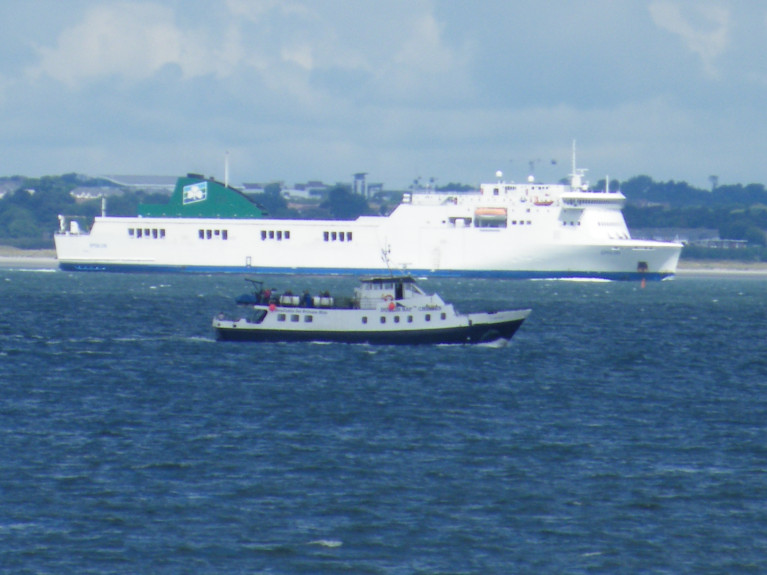Displaying items by tag: DublinFrance
Shipping Snippets from a Dublin Bay Perspective As Seasons Change to Reflect Times
Cruiseferry W.B. Yeats made its final layover today, which occurs every Monday in between operating two round trips weekly during the summer/high season months on Irish Ferries Dublin-Cherbourg route, writes Jehan Ashmore.
The year round Ireland-France service will be taken over by the considerably smaller ropax Epsilon which remains on charter to parent company Irish Continental Group. Today's 'underway' layover involved W.B. Yeats vacate Dublin Port with the cruiseferry departing Dublin Bay and offshore of Lambay Island while berths at the ferryport terminal (No.1) were occupied in servicing Holyhead, Wales.
W.B. Yeats final round trip in a season notably impacted by Covid-19, departs Dublin tomorrow to Cherbourg with a return to the Irish capital to be completed on Thursday. On the same day this is be followed by Epsilon's resumption on the Ireland-France service. The ropax returns to winter months duties connecting Normandy but based on an 'economy' class service while the cruiseferry rejoins Ulysses on the Holyhead link.
As for Stena Line operations a separate story is to follow suit.
More on the merchant shipping scene as a pair of Arklow Shipping cargoships are docked in south Wales at Swansea Dry Docks. They are the Irish flagged D class Arklow Dale (11,000dwat) and from the F series, Arklow Faith (4,950dwat). The former trader is one of a quartet of secondhand tonnage which ASL acquired in 2018.
The dry dock facility in West Glamorgan has benefitted since the closure of Dublin Dry Docks in 2016 when ASL became the final customer with another F series in the form of Arklow Fame. Also taking up some of this business but across the other side of the Celtic Sea has led to Cork Dockyard, part of the Doyle Shipping Group.
As for leisurely persuits, excursion passenger vessel, St.Bridget, operated by Dublin Bay Cruises completed its summer season albeit with much reduced capacity. Each of the former 100 capacity cruises during a shortened season were restricted to Covid-19 public health guidelines which resulted to just 40 sight-seers.
Among the excursions offered was a mid-afternoon round Dalkey Island coastal cruise which yesterday concluded the final trip into the bay for this year. Despite the setback of a shorter season imposed by Covid-19, some excursions attracted the private charter of the St. Bridget with cruises observed off Dalkey Island.
Over the years St. Bridget which was based in Dun Laoghaire Harbour has wintered in Dublin Port by laying-up in the Grand Canal Dock Basin, Ringsend.
#ferries - At a major international shipping awards ceremony, Irish Ferries has triumphed by taking home both the Ferry Concept Award and the Interior Architecture Award for their recently launched cruise-ferry, the W.B. Yeats.
The annual Shippax Industry Awards ceremony, which was last night held aboard the MS Silja Serenade in Stockholm, recognises newly-delivered ferries and cruise vessels that demonstrate creativity and design innovation.
Ahead of its 'maiden' voyage from Cherbourg to Dublin tomorrow, the W.B. Yeats (first actual sailing Afloat adds takes place today and from Dublin) received the Shippax Interior Architecture Award for a contemporary design that employs understated elegance and natural tones throughout. Relaxing cabins and luxury suites, as well as attractive public areas such as the ‘Innisfree’ Club Class Lounge and the ‘Maud Gonne’ lounge and bar, were acclaimed. Unique style elements, including the use of energy efficient LED lighting systems, also received high praise.
With the flexibility to cover both short sea (Irish Sea) and long sea (Dublin-France) routes, the ship’s state-of-the-art design and configuration was also recognised by the jury who awarded the W.B. Yeats with the Shippax Ferry Concept Award.
Measuring 195m in length and capable of transporting 300 cars, 165 trucks and 1,800 passengers, the W.B. Yeats is dynamic in design and modern in technology, meeting both tourism and freight customer needs. Its separate 295-car deck is located directly beneath the accommodation decks, guaranteeing easy access for passengers. While the separation of commercial vehicles improves safety and allows for an optimised 2,800-lanemetre cargo intake.
Andrew Sheen, Managing Director of Irish Ferries said, “The Shippax Awards are among the most prestigious accolades within the cruise-ferry industry, so we are incredibly proud that the W.B. Yeats has been recognised both for its stunning interior and innovative design. The ship is a game changer not just in terms of cruise-ferry travel between France and Ireland, but also in the context of setting a new benchmark for cruise-ferry travel world-wide.”
The sailing is the first of up to four departures per week from France to Dublin and is expected provide a major boost to trade and tourism between France and Ireland.























